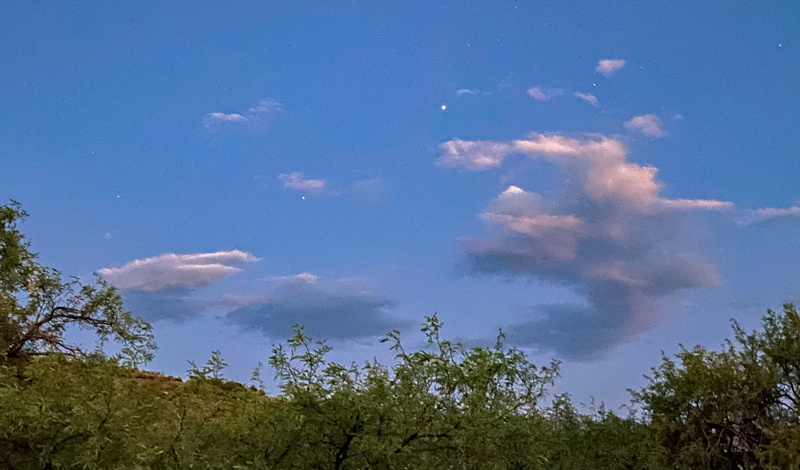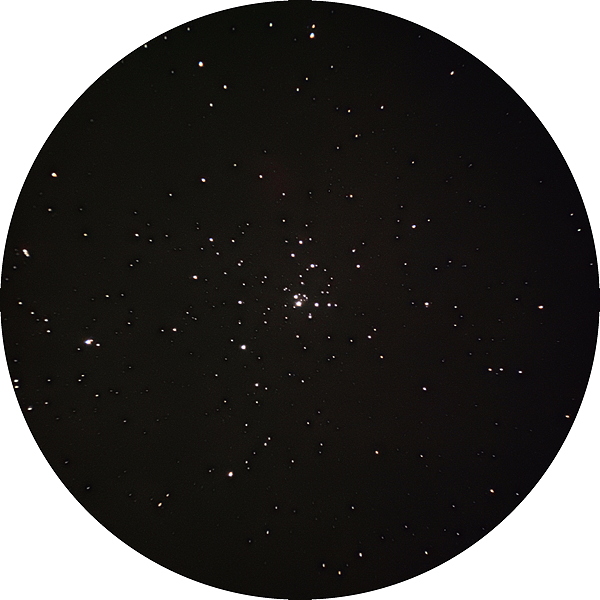iPhone Messier Catalog Object Astrophotography
Posted: 10 August 2020
|
Open: Sunday, 9 August 2020, 1904 MST Temperature: 103°F |
Session: 1507 Conditions: Clear |
Equipment:
12" f/8 LX600 w/StarLock
2" 24mm UWA eyepiece
1.25" 15mm eyepiece
2" 30mm eyepiece
Camera:
iPhone 11 Pro Max
After opening the observatory dome I SYNCed the observatory clock to WWV time signals. I then began relaxing on the observatory patio bench.
1916 MST: sunset. Some clouds were low in the southeastern sky near the planets Saturn and Jupiter, as seen in this iPhone 11 Pro Max photo taken at 1951 MST with the iOS Camera app (Night Mode, 3 seconds, 2X lens).

2000 MST: back inside the observatory.
2004 MST: LX600 ON, StarLock OFF, High Precision OFF.
Viewed Jupiter and the four Galilean Moons, 102X. Saturn was hidden by clouds.
Then viewed M14 (globular cluster), 102X.
2010 MST: dome OFF (onto my new replacement PZT).
Viewed M14 (globular cluster), 163X. Began waiting for the sky to get darker.
2018 MST: clouds were decreasing. Took this handheld iPhone 11 Pro Max photo (Night Mode, 10 seconds, 1X lens) of the southern sky.

Mouseover or tap on image for labels
Mounted the iPhone on the 15mm eyepiece using the Levenhuk adapter.
2042 MST: StarLock ON.
I took the following StarLock autoguided iPhone using NightCap Camera (Long Exposure, Light Boost, ISO 12500, 1 second, 1 minute exposure, 1X lens).
M14 (globular cluster, 163X)

M28 (globular cluster, 163X)

M20 (Trifid Nebula, 81X)

M21 (open cluster, 81X)

M23 (open cluster, 81X)

M24 (Sagittarius Star Cloud, 81X)

M25 (open cluster, 81X)

M26 (open cluster, 81X)

I have now completed my Messier Catalog iPhone Astrophotography album update using the iPhone 11 Pro Max.
2131 MST: StarLock OFF.
Viewed Jupiter, 163X. The Great Red Spot was visible and there were many details visible in the cloud bands. Viewed Saturn, 163X and 102X. Both planets were nice views this night.
2148 MST: LX600 OFF.
2152 MST: dome ON.
I really like my new PZT. The dome slides easily OFF and back ON.
2156 MST: took a Sky Quality reading using the Unihedron SQM-L.
|
Close: Sunday, 9 August 2020, 2200 MST Temperature: 81°F |
Session Length: 2h 56m Conditions: Clear, SQM 21.13 |
Comments are welcome using Email. Twitter users can use the button below to tweet this report to their followers. Thanks.
Cassiopeia Observatory Home Page
Copyright ©2020 Michael L. Weasner / mweasner@me.com
URL = http://www.weasner.com/co/Reports/2020/08/10/index.html
